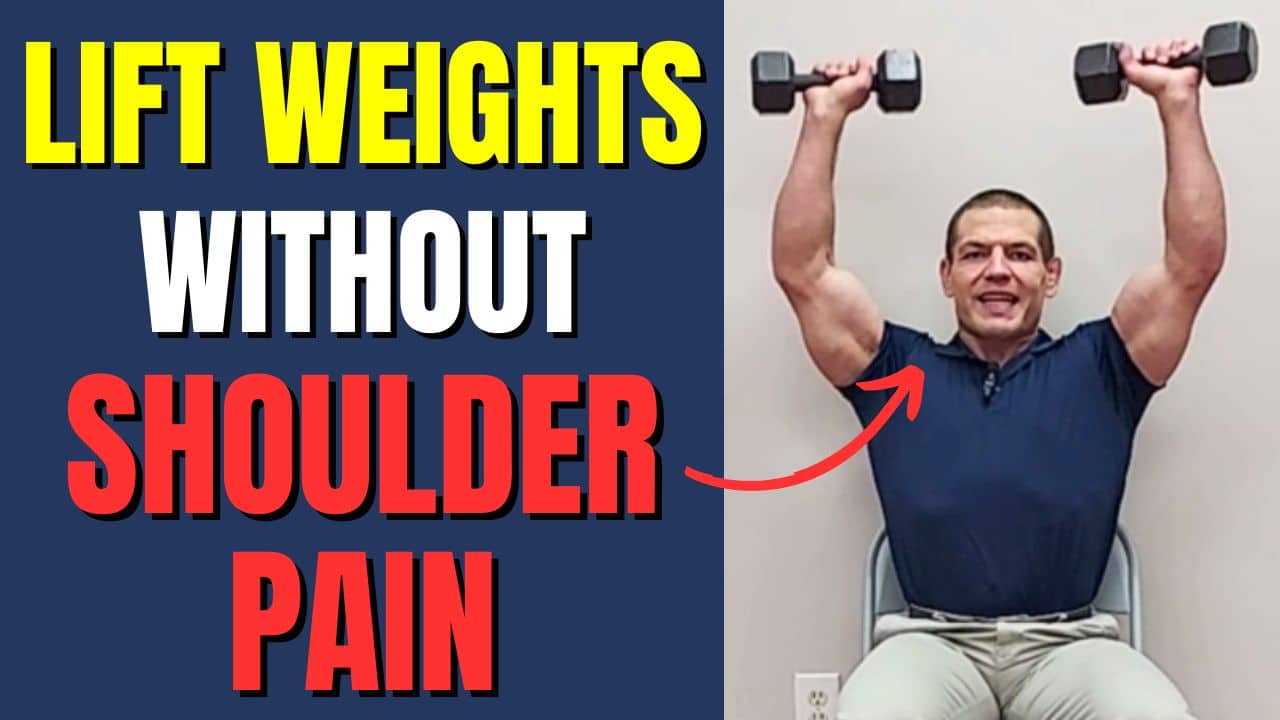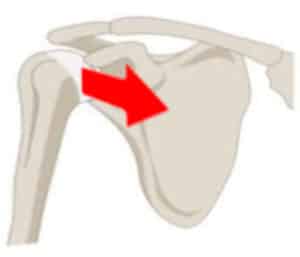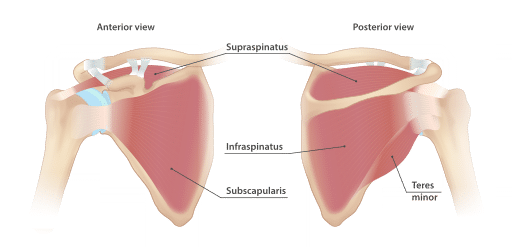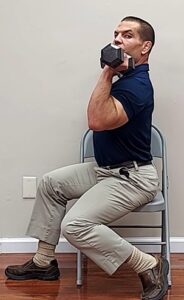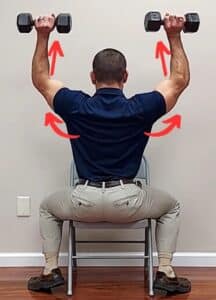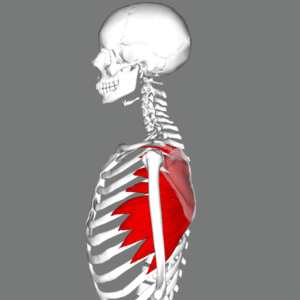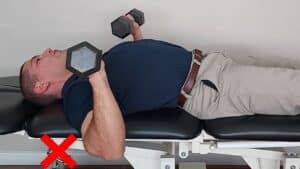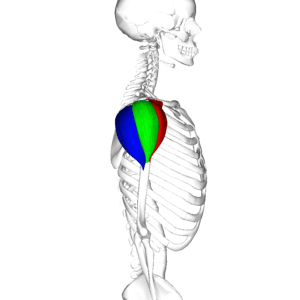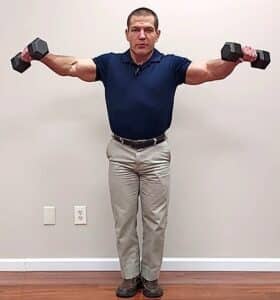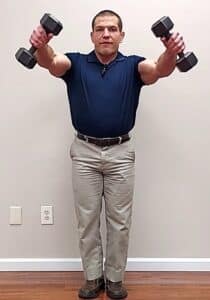Do You Get Shoulder Pain When Lifting Weights?
As an avid weightlifter myself, I know how annoying it is when you have to take time away from the gym due to an injury. Fortunately, with the right knowledge, you can decrease the likelihood of injuring your shoulder.
Watch the video to learn how you can continue working out without causing or worsening shoulder pain.

What Causes Shoulder Pain When Weight Lifting?
Most shoulder injuries from lifting weights happen with pushing movements such as bench press or shoulder press.
Additionally, shoulder exercises such as lateral raises and front raises may also provoke shoulder pain.
Later in this post, I'll give some specific tips for each of those exercises to do them more safely without injuring your shoulders.
Largely though, the things that cause shoulder injuries when you're lifting weights are either:
- going too heavy
- using improper form
- muscle imbalances.
One problem that happens when people are doing pressing movements is the ball of the shoulder coming too far forwards in the socket.
This in turn can pinch on the rotator cuff tendons, specifically the supraspinatus.
Additionally, your arm and your shoulder blade have to move together when you're doing overhead movements like shoulder presses.
If the shoulder blades and the arms aren't moving in proper sequencing and proper coordination, then you're more likely to injure the rotator cuff tendons.
Shoulder Pain Lifting Weight Overhead
Let's start out with the overhead shoulder press exercise because that's one of the most common exercises in which people develop shoulder pain when weight lifting.
Starting Position
With the shoulder press, I would highly recommend doing this sitting down with back support. This helps stabilize your lower back and isolate the movement to your shoulders and arms.
Additionally, I'd recommend using dumbbells rather than a barbell, particularly if you already have a shoulder injury.
Using dumbbells when lifting weights prevents your strong side from compensating for your weaker side. It also allows for better alignment when doing a shoulder press.
You want to keep your elbows slightly in front of the plane of your body when doing a shoulder press.
Many people think that you should do a shoulder press with your arms perfectly out to the side in line with your shoulders.
If you're using a barbell, of course, that wouldn't work because the bar would come down right on top of your head.
Even with dumbbells though, the shoulder blades are naturally angle forward a little bit due to the curve of your ribcage.
Therefore, you want to keep your elbows in this "scapular plane".
Additionally, keeping your elbows forward helps maintain shoulder external rotation.
You need this shoulder external rotation movement to clear the greater tuberosity, or a bump on your shoulder, so it doesn't pinch the rotator cuff tendons.
Failure to get shoulder external rotation is another reason why people get shoulder pain when lifting weights overhead.
Lifting the Weights
You don't want to just think about lifting the weights with just your arms.
You need to get your shoulder blades moving in coordination with your arms.
When you're lifting weight overhead, you want your shoulder blades to move up and away from the spine (upward rotation). Then your arms follow along.
Keep your shoulders externally rotated wit your elbows forward as you lift.
Then return to the starting position and repeat.
Shoulder Pain When Bench Pressing
Next, we'll move on to a bench press.
When you do a bench press, your shoulder blades need to move away from your spine using a muscle called the serratus anterior.
You want to first think about the shoulder blade movement of moving your shoulder blades away from the spine to activate your serratus anterior.
This gives your chest muscles a better line of pull on your humerus, or arm bone.
Lowering the Weight
Start the movement by protracting your shoulders and pushing your upper back down into the bench with the weight at the top position.
As you lower the weight down toward your chest, your shoulder blades will come together in the back, but you should still maintain tension in your serratus anterior throughout the movement.
If you're not competing, in a powerlifting competition, I would recommend stopping a few inches short of the bar hitting your chest when doing a bench press.
You don't want to let your elbow drop down too far past the plane of your body.
Doing so causes the ball of your shoulder to glide forward. That in turn makes you more likely to pinch the rotator cuff tendons.
Lifting the Weight
Once you've reached the bottom of the motion, you want to think about starting the motion by driving your upper back into the bench, and activating your serratus anterior and chest muscles to bring the shoulder blades away from your spine first.
Then continue the motion by bringing your elbows together. People will often describe this as "breaking the bar". If you think about bending the barbell in half, this activates your serratus anterior and gives you some shoulder external rotation.
During the bench press, you also want to keep your chin tucked position as opposed to pressing your head back into the bench.
Pushing your head into the bench extends your neck and can either pinch nerves in your neck or strain your neck muscles.
Shoulder Pain With Lateral Raises
Lateral raises work your lateral deltoids muscles (green below).
To do a lateral raise, you raise your arms out to the side.
Your deltoids have an upward and outward pull on your shoulder.
This upward pull can cause the head of the humerus to rid up in the socket and pinch your rotator cuff tendons under the arch of the shoulder.
Rotator cuff action when lifting weights
To avoid impinging your rotator cuff tendons, you need to use your rotator cuff tendons to pull the ball of the shoulder down as you're raising the arm up.
This helps keep the ball centered in the socket.
Scapular motion when lifting weights
Additionally, you need to be able to move the shoulder blades up and out so the arch of the shoulder should actually raise up as you're doing a lateral raise.
To do that, you don't want to think about a pure axis of rotation around the shoulder joint right there.
You want to actually think about flaring your shoulder blades out to the side like that.
That'll again activate your serratus anterior. Then you follow through with activating your deltoids and raising your arms.
Moving your shoulder blades gives your deltoids a better line of pull throughout the movement. It also helps you avoid pinching your rotator cuff tendons.
Avoid doing a lateral raise above shoulder level as you'll be more likely to develop shoulder pain lifting above 90 degrees.
The top part of of a lateral raise is the most difficult part. Therefore, you may need to do your first couple of repetitions all the way up to 90 degrees.
Then as you fatigue, it's actually okay with this exercise if you go a little less high with subsequent reps.
This will help maximally fatigue your deltoids without risking injuring your rotator cuff muscles.
Shoulder Pain With Front Raises
The final exercise is the front raise, which works your anterior deltoid (red in the image above).
It's best for your shoulder joint position to have your thumb up when doing this exercise.
However, doing so allows your biceps to act as a shoulder flexor, so it's probably the best compromise to have your arms about halfway between palm down and palm in.
Similarly to the lateral raise, you only want to lift the weight up to shoulder level to avoid pinching the rotator cuff tendons.
Additionally, you want to think about tipping your shoulder blades backward, as your lifting the weight forward.
This helps raise the arch over the shoulder blade upwards so that you don't pinch your rotator cuff tendons.
Last Words On Shoulder Pain When Weight Lifting
Hopefully you found these tips helpful to allow you to continue lifting weights without shoulder pain.
If you do experience shoulder pain when lifting weights, I'd highly advise not trying to fix the problem yourself.
The shoulder joint is incredibly complex, and the heavier you lift, the more important it is to use proper technique.
Seeing a physical therapist who has great knowledge of shoulder biomechanics can help you get back to the gym safely.
If you're in the St. Louis area and you need help for shoulder pain, we'd be happy to help you here at More 4 Life.
Just tap the button below to request an appointment with one of our orthopedic specialist physical therapists.
Like this post? Read some of our other posts about shoulder pain:
Can I Exercise With A Rotator Cuff Injury?
8 Rotator Cuff Strengthening Exercises

